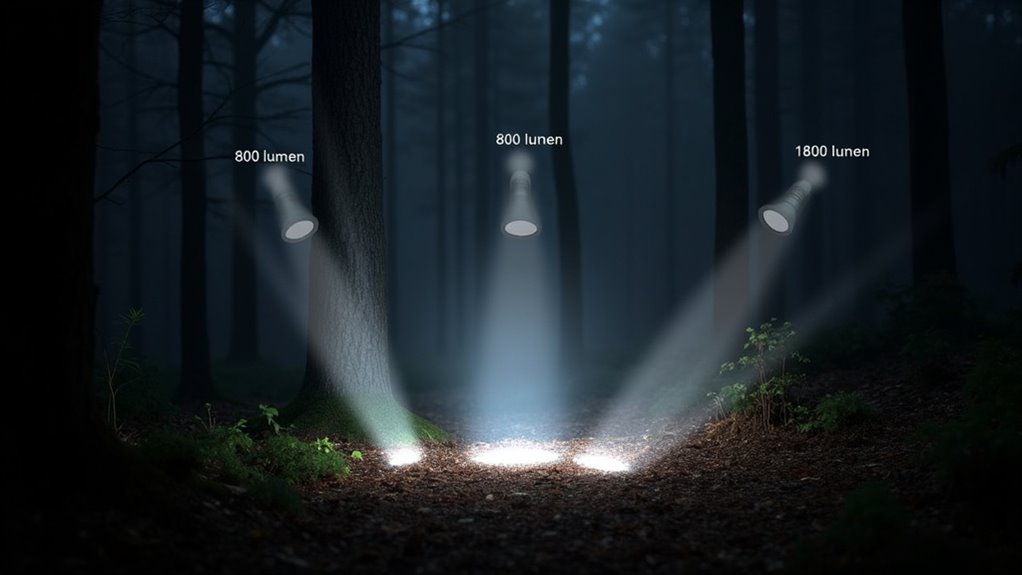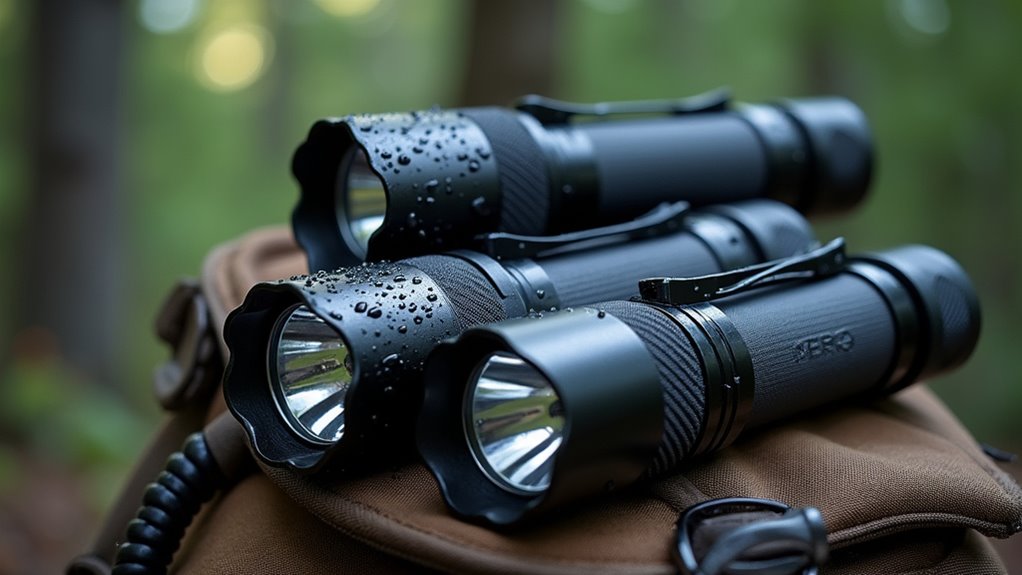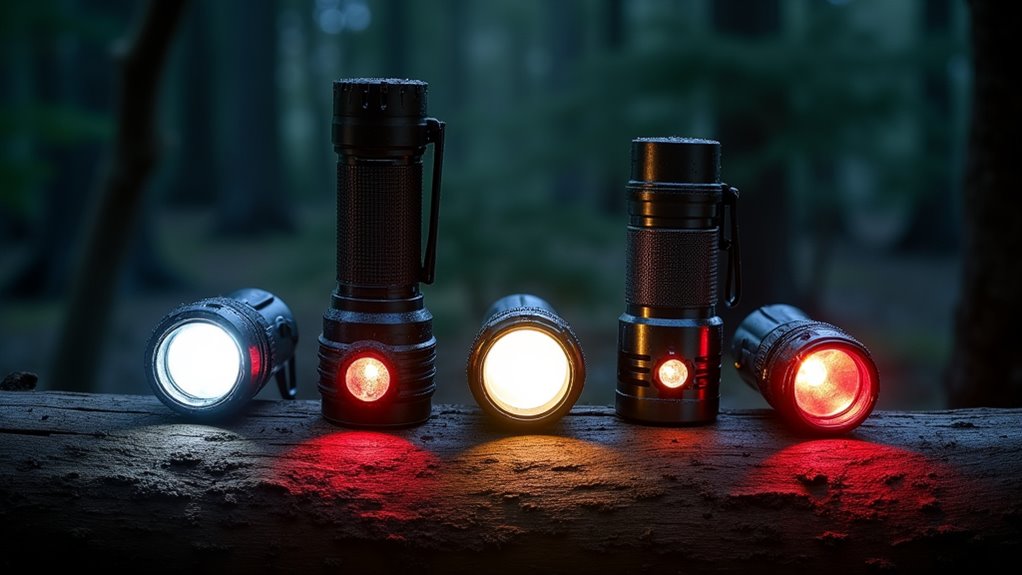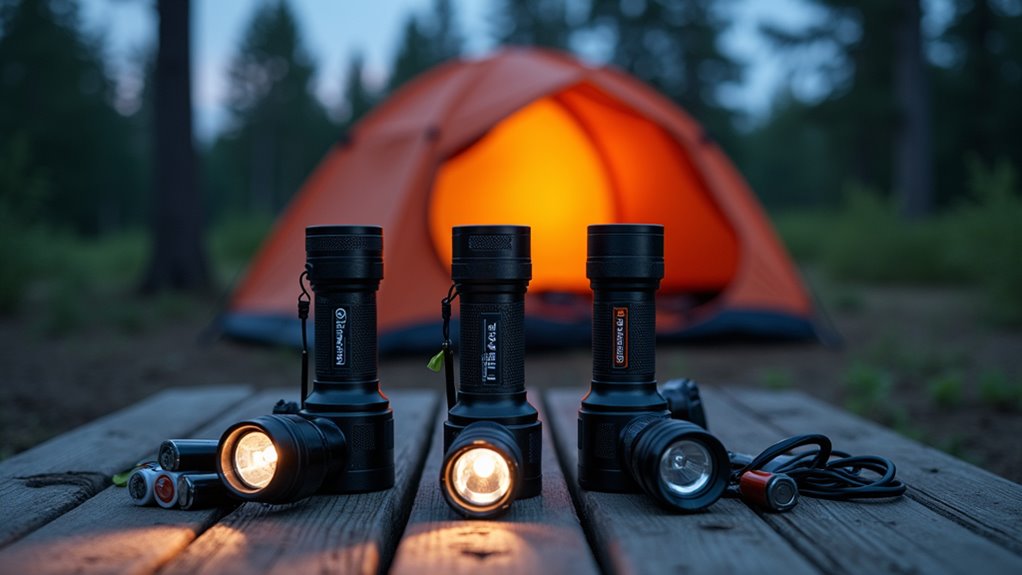Physical Address
304 North Cardinal St.
Dorchester Center, MA 02124
Physical Address
304 North Cardinal St.
Dorchester Center, MA 02124

Navigate the crucial factors of selecting your camping flashlight, from brightness levels to power sources—your night safety depends on it.
When you’re setting up camp after sunset or traversing a trail in the dark, your flashlight becomes your most essential piece of gear. You will need to make smart choices about brightness, durability, and power options before heading into the wilderness. While it’s tempting to grab the cheapest light at the store, a poorly chosen flashlight can leave you frustrated or even stranded. Let’s explore the key features that’ll guarantee you pick the right companion for your outdoor adventures.

When choosing a camping flashlight, understanding lumens is essential since they measure the total light output of your device. Think of lumens like a car’s horsepower – the higher the number, the more light you’ll get.
However, more isn’t always better for camping. For most camping activities, you’ll want a flashlight with multiple brightness settings. Low settings of 10-20 lumens work well for night navigation and conserve battery life, while 100-500 lumens are perfect for camp setup and cooking. Having focused beam patterns can actually provide better visibility than higher lumen outputs when lighting up distant objects. An Essential Guide to Selecting the Perfect Camping Flashlight can help you make an informed decision.
If you need to illuminate larger areas or want extra versatility, consider a light with 300-1000 lumens. While some flashlights offer extreme outputs up to 3200 lumens, they’ll drain your batteries quickly and might disturb wildlife and fellow campers.
Since your flashlight is only as reliable as its power source, choosing the right battery type can make or break your camping experience.
A reliable flashlight starts with the right battery – it’s the cornerstone of safe, worry-free camping adventures.
For weekend trips, rechargeable NiMH AA or AAA batteries offer the best value – they’re cost-effective and environmentally friendly. Their 2000-3000mAh capacity makes them perfect for moderate-use camping scenarios. If you’re heading out for longer adventures, consider 18650 lithium-ion batteries, which pack more power and handle extreme temperatures better.
For emergency backup, always carry single-use CR123A batteries; they’re reliable and have a long shelf life. Solar-powered options are worth considering for extended trips, though they shouldn’t be your only power source.
Whatever you choose, match the battery type to your flashlight’s specifications and consider the weight-to-power ratio for your specific needs.
Remember to store your batteries properly and check them before each trip to avoid surprises in the wilderness.

Because your flashlight needs to withstand rough handling in unpredictable outdoor conditions, durability features should be at the top of your checklist.
Look for models with aluminum alloy or tactical polymer construction – they’ll give you excellent durability without weighing down your pack. Make sure you’re getting IPX7 or higher water resistance rating, which means your light can handle heavy rain or accidental drops in shallow water.
Choose a flashlight with shockproof LED technology and reinforced head caps to protect against inevitable drops. High-performance models typically offer longer beam distances for better navigation through dark trails. Recessed switches and rubber grip coating will prevent accidental activation and provide better handling in wet conditions.
For serious backcountry trips, consider models that meet military standards (MIL-STD-810G) – they’re tested for extreme temperatures, drops, and harsh weather conditions. Plus, essential safety tips should be considered when choosing a camping flashlight.
Every camping flashlight should include multiple light modes to handle diverse outdoor situations effectively.
You’ll want essential features like red light mode to preserve your night vision and avoid disturbing fellow campers, plus dimmable settings to conserve battery life when full brightness isn’t needed. Modern LED flashlights provide exceptional brightness while maintaining impressive battery run times.

When selecting a camping flashlight, three critical factors – size, weight, and portability – can make or break your outdoor experience. You should aim to strike the right balance between functionality and convenience, as every ounce matters on the trail.
Consider compact models like the ThruNite Archer 2A V3, weighing just 1.69 oz, if you’re planning lightweight trips. While smaller flashlights typically offer shorter beam distances, many modern options deliver impressive performance. The NITECORE EDC27, for instance, packs 3,000 lumens into a 4.37 oz frame. For optimal versatility, look for models with rechargeable lithium-ion batteries that provide both convenience and reliable power.
Essential Camping Gear can also help you make the right choice for your next outdoor adventure. Look for aluminum construction and efficient designs that include clip options for easy access.
Don’t assume you need the biggest light for the best performance – today’s battery technology allows compact flashlights to deliver substantial power while keeping your pack weight down.
Since weather can turn nasty without warning during camping trips, you’ll need a flashlight that won’t fail in harsh conditions. Look for models with at least an IPX4 rating for protection against splashing water from any direction, though IPX7 is better if you can afford it, allowing submersion up to 1 meter.
Your flashlight’s weather resistance could mean the difference between a minor inconvenience and a camping emergency. The FLATEYE UNROUND design provides enhanced grip stability and prevents the flashlight from rolling away on uneven surfaces during wet conditions. Essential safety gear is crucial for a successful camping trip.

Beyond weather protection, the right practical features can make or break your camping experience.
Look for a flashlight with multiple brightness modes – you’ll want high lumens for emergencies and low settings to preserve battery life. A light measuring 1607 lux like the Nitecore provides excellent beam intensity for spotting wildlife at night. Hands-free options like magnetic bases or clips are invaluable when you’re cooking or fixing gear in the dark.
A versatile flashlight with adjustable brightness and hands-free features transforms from emergency tool to essential camping companion.
Consider models with red light capability to maintain your night vision and avoid disturbing campmates. USB-C charging ports that double as power banks can be lifesavers for your devices, eliminating the need for extra chargers. LED flashlights are ideal for illuminating your camping adventure.
Don’t overlook ergonomic features like large, glove-friendly buttons and comfortable grips – they’re essential when you’re fumbling around in cold or wet conditions.
Choose adjustable beam focus to switch between spotlighting distant objects and flooding your campsite with light.
Three key factors determine your flashlight’s reliability on camping trips: battery type, runtime, and charging capability. You should aim to balance these elements based on your specific camping needs and duration.

When choosing a camping flashlight, you’ll find quality options across three distinct price ranges: budget models under $50, mid-range units between $50-$120, and premium lights above $120.
For the best value, consider the Sofirn SP36 PRO at around $50, delivering an impressive 8,000 lumens with USB-C charging. If you’re watching your budget but need reliability, the Acebeam TAC 2AA offers 1,600 lumens and versatile power options at $50. The ThruNite Archer 2A V3 is another excellent budget choice with its 500 lumens output and readily available AA batteries.
Don’t go below $35, as these models often compromise on durability and performance.
For serious campers, mid-range options like the Nitecore EDC33 ($70) strike an ideal balance between cost and features. It provides 4,000 lumens and excellent range.
You’ll find that investing in a quality camping flashlight pays off, considering the average camper uses their light for 4.2 hours per night during trips. Choose a model that balances your needs – aim for 300+ lumens, IPX7 waterproofing, and multiple light modes without breaking the bank. Whether you’re spending $30 or $100, focus on durability and battery life to guarantee your light won’t leave you in the dark.